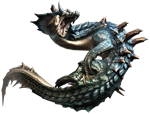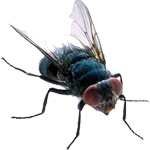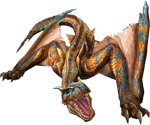Random Topic
not to mention Gwangi comes from the same genre as movies of the likes of 'Babes in Toyland' [Drew Barrymore and Keenu Reeves vs. evil christmas trees...-_-], 'The Giant Claw' [horrible giant vulture puppet that looks like a sock with a couple of eyeballs attached] and 'Attack of the Killer Tomatoes' [no joke. that's a real movie. http://www.badmovies.org/movies/killtomato/]. so yeah, his ability doesn't stand for much....
"Ah yes, organised chaos. the sign of a clever but ever-busy mind. To the perpetrator, a carefully woven web of belongings and intrigue, but to the bystander? Madness!"
–William Beckett, Lore of Leyuna RPG

–William Beckett, Lore of Leyuna RPG

-

The Kingpin - Webmaster

- Posts: 22584
- Joined: Thu Jan 01, 1970 12:00 am
- Location: Kuwait
Dear god!!! Don't even bring UP the giant claw!!! The monster is the stupidest Kaiju in history!!!
If you want a good dino movie that the dinos AREN'T UNKILLABLE, GIRA, watch 1 million years B.C. Sure, it's a little unrealistic (archelon was NOT that big), but as Harryhausen said, "It wasn't for the professors of the world".
@ TT: Well, let's look at their stats:
(Here's how I'll judge. 1 pt to the lower stat, 2 pts to the better stat. let's go!!!!)
T-rex:Size- Large Pt:1
Body structure- sturdy Pt: 1
Speed-can run moderately fast (from what the scientists know) Pt: 2
Unique traits- has the strongest bite force of any land animal Pt: 2
Intelligence Level- reasonably smart Pt: 2
Giga: Size-HUGE Pt: 2
Body structure- sturdy Pt: 1
Speed- a bit on the slow side Pt: 1
Unique traits- has large claws for hunting Pt: 2
Intelligence level- not quite as smart Pt: 1
Totals:
T-rex: 8 pts
Giga: 7 pts
I guess You're right, TT. T-rex is a better overall predator.
If you want a good dino movie that the dinos AREN'T UNKILLABLE, GIRA, watch 1 million years B.C. Sure, it's a little unrealistic (archelon was NOT that big), but as Harryhausen said, "It wasn't for the professors of the world".
@ TT: Well, let's look at their stats:
(Here's how I'll judge. 1 pt to the lower stat, 2 pts to the better stat. let's go!!!!)
T-rex:Size- Large Pt:1
Body structure- sturdy Pt: 1
Speed-can run moderately fast (from what the scientists know) Pt: 2
Unique traits- has the strongest bite force of any land animal Pt: 2
Intelligence Level- reasonably smart Pt: 2
Giga: Size-HUGE Pt: 2
Body structure- sturdy Pt: 1
Speed- a bit on the slow side Pt: 1
Unique traits- has large claws for hunting Pt: 2
Intelligence level- not quite as smart Pt: 1
Totals:
T-rex: 8 pts
Giga: 7 pts
I guess You're right, TT. T-rex is a better overall predator.
"If none can know what lies ahead, then losing one's way is just human nature."~ Yoshimitsu
"Would you hear my desire? To take this foul blade, and use it to blot out the light forever!" ~ Ganondorf
"Would you hear my desire? To take this foul blade, and use it to blot out the light forever!" ~ Ganondorf
-

Godzilla Forever - Leviathan

- Posts: 14715
- Joined: Sat Sep 05, 2009 3:19 am
- Location: In San Fransisco defeating the MUTOs.
The Giganotosaurus wasn't that huge, 1 or 2 meters more than the Tyrannosaurus at most, Here is a quote comparing both Dinosaurs.
Tyrannosaurus Rex was one of the largest land carnivores of all time; the largest complete specimen, FMNH PR2081 ("Sue"), measured 12.8 meters (42 ft) long, and was 4.0 meters (13 ft) tall at the hips. Mass estimates have varied widely over the years, from more than 7.2 metric tons (7.9 short tons), to less than 4.5 metric tons (5.0 short tons), with most modern estimates ranging between 5.4 and 6.8 metric tons (6.0 and 7.5 short tons). Although Tyrannosaurus Rex was larger than the well known Jurassic theropod Allosaurus, it was slightly smaller than Cretaceous carnivores Spinosaurus and Giganotosaurus.
The neck of Tyrannosaurus rex formed a natural S-shaped curve like that of other theropods, but was short and muscular to support the massive head. The forelimbs had only two clawed fingers, along with an additional small metacarpal representing the remnant of a third digit. In contrast the hind limbs were among the longest in proportion to body size of any theropod. The tail was heavy and long, sometimes containing over forty vertebrae, in order to balance the massive head and torso. To compensate for the immense bulk of the animal, many bones throughout the skeleton were hollow, reducing its weight without significant loss of strength.
The largest known Tyrannosaurus Rex skulls measure up to 5 feet (1.5 m) in length. Large fenestrae (openings) in the skull reduced weight and provided areas for muscle attachment, as in all carnivorous theropods. But in other respects Tyrannosaurus’ skull was significantly different from those of large non-tyrannosauroid theropods. It was extremely wide at the rear but had a narrow snout, allowing unusually good binocular vision. The skull bones were massive and the nasals and some other bones were fused, preventing movement between them; but many were pneumatized (contained a "honeycomb" of tiny air spaces) which may have made the bones more flexible as well as lighter. These and other skull-strengthening features are part of the tyrannosaurid trend towards an increasingly powerful bite, which easily surpassed that of all non-tyrannosaurids. The tip of the upper jaw was U-shaped (most non-tyrannosauroid carnivores had V-shaped upper jaws), which increased the amount of tissue and bone a tyrannosaur could rip out with one bite, although it also increased the stresses on the front teeth.
Profile view of a Tyrannosaurus skull (AMNH 5027)
The teeth of Tyrannosaurus Rex displayed marked heterodoxy (differences in shape). The premaxillary teeth at the front of the upper jaw were closely packed, D-shaped in cross-section, had reinforcing ridges on the rear surface, were incisiform (their tips were chisel-like blades) and curved backwards. The D-shaped cross-section, reinforcing ridges and backwards curve reduced the risk that the teeth would snap when Tyrannosaurus bit and pulled. The remaining teeth were robust, like "lethal bananas" rather than daggers; more widely spaced and also had reinforcing ridges. Those in the upper jaw were larger than those in all but the rear of the lower jaw. The largest found so far is estimated to have been 30 centimetres (12 in) long including the root when the animal was alive, making it the largest tooth of any carnivorous dinosaur.
Giganotosaurus carolinii was named for Ruben Carolini, an amateur fossil hunter who, in 1993, discovered the fossils in deposits of Patagonia (southern Argentina) in what is now considered the Candeleros Formation. It was published by Rodolfo Coria and Leonardo Salgado in the journal Nature in 1995.
The holotype specimen's (MUCPv-Ch1) skeleton was about 70% complete and included the skull, pelvis, leg bones and most of the backbone. Various estimates find that it measured somewhere between 12.2 and 12.5 m (40-41 ft) in length, and between 6.5 and 13.3 tons in weight. A second, more fragmentary, specimen (MUCPv-95) has also been recovered. It is only known from a portion of the left dentary which is 8% larger than the equivalent bone from the holotype. This largest Giganotosaurus specimen is estimated to represent an individual with a skull length of 195 cm (6.3 ft), compared to the holotype's estimated at 1.80 m (6 ft) skull, making it likely that Giganotosaurus had the largest skull of any known theropod. Giganotosaurus surpassed Tyrannosaurus in mass by at least half a ton (the upper size estimate for T. rex is 9.1 t).
G. carolinii was slightly larger than T. Rex, but had a brain only about half as big as those of tyrannosaurids. The teeth of Tyrannosaurus were longer and wider, and more variable in size. The teeth of Giganotosaurus were shorter, less variable and narrower than those of Tyrannosaurus, and were more adapted for slicing flesh. A well-developed olfactory region means that it probably had a good sense of smell. Its skull, although large, had a slender build.
Titanosaur fossils have been recovered near the remains of Giganotosaurus, leading to speculation that these carnivores may have preyed on the giant herbivores. Fossils of related carcharodontosaurids grouped closely together may indicate pack hunting, a behavior that could possibly extend to Giganotosaurus itself.
Blanco and Mazzetta (2001) estimated that Giganotosaurus might have been capable of running at speeds up to 14 metres per second (31 mph).
We won't be here tomorrow, Hold on to me for one last time
-

Alpha - House fly

- Posts: 203
- Joined: Mon Nov 09, 2009 1:59 am
- Location: Unknown
Wow.... I've got my info kinda jumbled.....
still, T-rex would've won.
still, T-rex would've won.
"If none can know what lies ahead, then losing one's way is just human nature."~ Yoshimitsu
"Would you hear my desire? To take this foul blade, and use it to blot out the light forever!" ~ Ganondorf
"Would you hear my desire? To take this foul blade, and use it to blot out the light forever!" ~ Ganondorf
-

Godzilla Forever - Leviathan

- Posts: 14715
- Joined: Sat Sep 05, 2009 3:19 am
- Location: In San Fransisco defeating the MUTOs.
That's awesome, iceking!!!!
"If none can know what lies ahead, then losing one's way is just human nature."~ Yoshimitsu
"Would you hear my desire? To take this foul blade, and use it to blot out the light forever!" ~ Ganondorf
"Would you hear my desire? To take this foul blade, and use it to blot out the light forever!" ~ Ganondorf
-

Godzilla Forever - Leviathan

- Posts: 14715
- Joined: Sat Sep 05, 2009 3:19 am
- Location: In San Fransisco defeating the MUTOs.
I didn't know that. i know that the quest is "a Troublesome Pair", but I don't know if they are Silver and gold.
"If none can know what lies ahead, then losing one's way is just human nature."~ Yoshimitsu
"Would you hear my desire? To take this foul blade, and use it to blot out the light forever!" ~ Ganondorf
"Would you hear my desire? To take this foul blade, and use it to blot out the light forever!" ~ Ganondorf
-

Godzilla Forever - Leviathan

- Posts: 14715
- Joined: Sat Sep 05, 2009 3:19 am
- Location: In San Fransisco defeating the MUTOs.
Bowser: While Gira fails at arguing about how stuff seen in B-horror films are canon, I'll share with you all, due to me being too lay to make this it's own page, TUSKED CROCODILES!
http://news.yahoo.com/s/ap/20091119/ap_ ... _odd_crocs
http://news.yahoo.com/s/ap/20091119/ap_ ... _odd_crocs

All hail the glory that is Tenshi, the Sunkern!
-

Giratina93 - Psuedo-Wyvern

- Posts: 11587
- Joined: Sun Jan 04, 2009 9:47 pm
- Location: Studying the ancient art of perfection
?! Madness!!!
Krythnriin: What the heck?.......
Krythnriin: What the heck?.......
"If none can know what lies ahead, then losing one's way is just human nature."~ Yoshimitsu
"Would you hear my desire? To take this foul blade, and use it to blot out the light forever!" ~ Ganondorf
"Would you hear my desire? To take this foul blade, and use it to blot out the light forever!" ~ Ganondorf
-

Godzilla Forever - Leviathan

- Posts: 14715
- Joined: Sat Sep 05, 2009 3:19 am
- Location: In San Fransisco defeating the MUTOs.
Man, I don't even have eager cleaver, and you have whatever that is......
"If none can know what lies ahead, then losing one's way is just human nature."~ Yoshimitsu
"Would you hear my desire? To take this foul blade, and use it to blot out the light forever!" ~ Ganondorf
"Would you hear my desire? To take this foul blade, and use it to blot out the light forever!" ~ Ganondorf
-

Godzilla Forever - Leviathan

- Posts: 14715
- Joined: Sat Sep 05, 2009 3:19 am
- Location: In San Fransisco defeating the MUTOs.
no dice yet, IK. I'm gonna try & make the garuga suit, then take him on.
"If none can know what lies ahead, then losing one's way is just human nature."~ Yoshimitsu
"Would you hear my desire? To take this foul blade, and use it to blot out the light forever!" ~ Ganondorf
"Would you hear my desire? To take this foul blade, and use it to blot out the light forever!" ~ Ganondorf
-

Godzilla Forever - Leviathan

- Posts: 14715
- Joined: Sat Sep 05, 2009 3:19 am
- Location: In San Fransisco defeating the MUTOs.
Who is online
Users browsing this forum: No registered users and 5 guests
Powered by phpBB © 2000, 2002, 2005, 2007 phpBB Group
SoftWood design by Free Forum
Time : 0.143s | 11 Queries | GZIP : Off
SoftWood design by Free Forum
Time : 0.143s | 11 Queries | GZIP : Off



